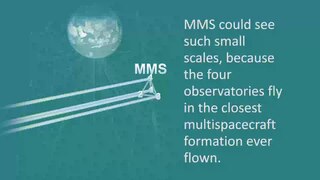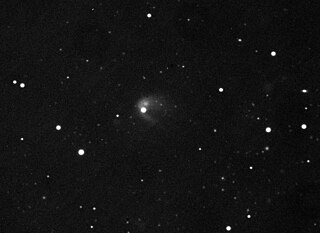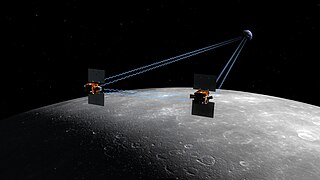Comet Shoemaker–Levy 9 broke apart in July 1992 and collided with Jupiter in July 1994, providing the first direct observation of an extraterrestrial collision of Solar System objects. This generated a large amount of coverage in the popular media, and the comet was closely observed by astronomers worldwide. The collision provided new information about Jupiter and highlighted its possible role in reducing space debris in the inner Solar System.

Comet Hyakutake is a comet discovered on 31 January 1996. It was dubbed the Great Comet of 1996; its passage to within 0.1 AU (15 Gm) of the Earth on 25 March was one of the closest cometary approaches of the previous 200 years. Reaching an apparent visual magnitude of zero and spanning nearly 80°, Hyakutake appeared very bright in the night sky and was widely seen around the world. The comet temporarily upstaged the much anticipated Comet Hale–Bopp, which was approaching the inner Solar System at the time.

In plasma physics, an Alfvén wave, named after Hannes Alfvén, is a type of plasma wave in which ions oscillate in response to a restoring force provided by an effective tension on the magnetic field lines.
Christopher Thomas Russell is head of the Space Physics Center at the Institute of Geophysics and Planetary Physics (IGPP) at UCLA, professor in UCLA's Department of Earth, Planetary, and Space Sciences, and Director of the UCLA Branch of the California Space Grant Consortium. He received a B.Sc. from the University of Toronto in 1964 and a Ph.D. from UCLA in 1968. In 1977 he was awarded the James B. Macelwane Medal and in 2003 the John Adam Fleming Medal by the American Geophysical Union (AGU). He is also a Fellow of the AGU. Asteroid 21459 Chrisrussell was named after him in 2008. In 2017, he was awarded the NASA Distinguished Public Service Medal. He has three grandchildren.
The interplanetary dust cloud, or zodiacal cloud, consists of cosmic dust that pervades the space between planets within planetary systems, such as the Solar System. This system of particles has been studied for many years in order to understand its nature, origin, and relationship to larger bodies. There are several methods to obtain space dust measurement.
Comet dust refers to cosmic dust that originates from a comet. Comet dust can provide clues to comets' origin. When the Earth passes through a comet dust trail, it can produce a meteor shower.

The nucleus is the solid, central part of a comet, formerly termed a dirty snowball or an icy dirtball. A cometary nucleus is composed of rock, dust, and frozen gases. When heated by the Sun, the gases sublime and produce an atmosphere surrounding the nucleus known as the coma. The force exerted on the coma by the Sun's radiation pressure and solar wind cause an enormous tail to form, which points away from the Sun. A typical comet nucleus has an albedo of 0.04. This is blacker than coal, and may be caused by a covering of dust.

The origin of water on Earth is the subject of a body of research in the fields of planetary science, astronomy, and astrobiology. Earth is unique among the rocky planets in the Solar System in having oceans of liquid water on its surface. Liquid water, which is necessary for all known forms of life, continues to exist on the surface of Earth because the planet is at a far enough distance from the Sun that it does not lose its water, but not so far that low temperatures cause all water on the planet to freeze.

Active asteroids are small Solar System bodies that have asteroid-like orbits but show comet-like visual characteristics. That is, they show a coma, tail, or other visual evidence of mass-loss, but their orbits remain within Jupiter's orbit. These bodies were originally designated main-belt comets (MBCs) in 2006 by astronomers David Jewitt and Henry Hsieh, but this name implies they are necessarily icy in composition like a comet and that they only exist within the main-belt, whereas the growing population of active asteroids shows that this is not always the case.

The Gravity Recovery and Interior Laboratory (GRAIL) was an American lunar science mission in NASA's Discovery Program which used high-quality gravitational field mapping of the Moon to determine its interior structure. The two small spacecraft GRAIL A (Ebb) and GRAIL B (Flow) were launched on 10 September 2011 aboard a single launch vehicle: the most-powerful configuration of a Delta II, the 7920H-10. GRAIL A separated from the rocket about nine minutes after launch, GRAIL B followed about eight minutes later. They arrived at their orbits around the Moon 25 hours apart. The first probe entered orbit on 31 December 2011 and the second followed on 1 January 2012. The two spacecraft impacted the Lunar surface on December 17, 2012.
The history of life on Earth traces the processes by which living and fossil organisms evolved, from the earliest emergence of life to present day. Earth formed about 4.5 billion years ago and evidence suggests that life emerged prior to 3.7 Ga. Although there is some evidence of life as early as 4.1 to 4.28 Ga, it remains controversial due to the possible non-biological formation of the purported fossils.
Jonathan I. Lunine is an American planetary scientist and physicist. Lunine teaches at Cornell University, where he is the David C. Duncan Professor in the Physical Sciences and chair of the Department of Astronomy. Having published more than 380 research papers, Lunine is at the forefront of research into planet formation, evolution, and habitability. His work includes analysis of brown dwarfs, gas giants, and planetary satellites. Within the Solar System, bodies with potential organic chemistry and prebiotic conditions, particularly Saturn's moon Titan, have been the focus of Lunine's research.
Jochen Mannhart is a German physicist.

Michel Devoret is a French physicist and F. W. Beinecke Professor of Applied Physics at Yale University. He also holds a position as the Director of the Applied Physics Nanofabrication Lab at Yale. He is known for his pioneering work on macroscopic quantum tunneling, and the single-electron pump as well as in groundbreaking contributions to initiating the fields of circuit quantum electrodynamics and quantronics.
Michael F. Hochella, Jr. is an American geoscientist and currently a university distinguished professor (Emeritus) at Virginia Tech and a laboratory fellow at Pacific Northwest National Laboratory. He is a Fellow of the American Association for the Advancement of Science, Royal Society of Chemistry, Geochemical Society, European Association of Geochemistry, Mineralogical Society of America, International Association of GeoChemistry, Geological Society of America and American Geophysical Union. His interests are nanogeoscience, minerals, biogeochemistry and geochemistry. Currently among greater than 22,500 citations, his highest cited first-author paper is Nanominerals, mineral nanoparticles, and earth systems at over 940 citations, and published in the journal Science in 2008, and his highest cited co-authored paper is Nanotechnology in the real world: Redeveloping the nanomaterial consumer products inventory at over 1,995 citations, and published in the Beilstein Journal of Nanotechnology in 2015, according to Google Scholar. He is a former President of both the Geochemical Society and the Mineralogical Society of America. He is also the Founder and former Director of NanoEarth, a node of the National Nanotechnology Coordinated Infrastructure (NNCI), an NSF-funded network of 16 centers spread throughout the United States serving as user facilities for cutting edge nanotechnology research. NanoEarth is part of Virginia Tech's Institute for Critical Technology and Applied Science (ICTAS), and headquartered in Blacksburg, Virginia. Hochella has won many honors, medals, and awards for both research and teaching, including the Dana Medal of the Mineralogical Society of America, the Clair C. Patterson Medal of the Geochemical Society, the Geochemistry Division Medal of the American Chemical Society, and the Virginia Outstanding Faculty Award, the highest honor for faculty in the Commonwealth of Virginia.
Terence Vincent Callaghan is a British biologist specialized in the ecology of the Arctic. Much of his work on arctic plants has taken place in Abisko in northernmost Sweden, based at the Abisko Scientific Research Station where he served as director. He was a lead author of the IPCC Fourth Assessment Reports chapter on polar regions.

Michael J. Mumma is an American astrobiologist at the Goddard Space Flight Center; he is best known for his investigation of the chemistry of comets.

Johannes "Jos" Lelieveld is a Dutch atmospheric chemist. Since 2000, he has been a Scientific Member of the Max Planck Society and director of the Atmospheric Chemistry Department at the Max Planck Institute for Chemistry in Mainz. He is also professor at the University of Mainz and at the Cyprus Institute in Nicosia.
Jerry X. Mitrovica is the Frank Baird Jr. Professor of Science in the Department of Earth and Planetary Sciences at Harvard University. He produced important early work showing that tectonic plates heave, tilt, and fall in addition to drifting across the surface of the planet. He is known for his work on modeling past and predicting future uneven rises and falls in sea level due to the interactions between melting ice caps, local gravitational forces, and plate tectonics, which yield what some might find to be counterintuitive results.








